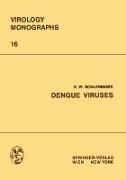Dengue Viruses
BücherAngebote / Angebote:
2. Virological Findings. 90 3. Immunity. . . . . 90 C. Secondary Dengue: Dengue Hemorrhagic Fever and the Shock Syndrome 92 1. General Remarks. . . . . . . . . . . . . . 92 2. Clinical Course and Clinical Laboratory Findings 93 3. Virological and Serological Findings. . . 95 4. Immunopathology of Secondary Dengue. 98 XI. Immunization. . . . . . . . . . . . . . . 104 A. Anamnestic Immune Responses in Sequential Infections With Dengue and Other Group B Togaviruses . . . . . . . . 104 1. Results With Members of the Dengue Subgroup 104 2. Results With Dengue and Other Flaviviruses. 107 B. Dengue Vaccines for Use in Man 108 XII. Opportunities for the Future 113 Acknowledgments. 114 References. . . . . . . . . . . 114 I. Introduction Dengue fever is a mosquito-transmitted disease of man which has afflicted untold millions of people over the past two centuries. It is caused by viruses classified as a subgroup of the group B togaviruses. Along with other members of that group as well as group A, the dengue viruses have been investigated intensively during recent years. Certain unique aspects of their structure, composition, antigenicity, replication, and antigenic relationships have established the togavirus family as quite distinct from other families of enveloped RNA viruses (see recent review of PFEFFERKORN and SHAPIRO, 1974). The basic studies leading to this conclusion have coincided with epidemiological field investigations which have resulted in a continuing increase in the number of viruses now designated as group A or B togaviruses. This, in turn, has led to a growing appreciation of their immense importance as actual or potential pathogens of man and beast.
Folgt in ca. 5 Arbeitstagen
